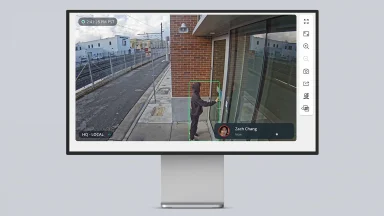Enhancing Investigations with Shortcuts in History and Selective Face Blurring
At Verkada, it’s important that we offer our customers the ability to investigate incidents easily and in a privacy-respecting manner. Today we’re excited to introduce two new features that directly ease and accelerate investigations and allow customers to archive and share past incidents while keeping privacy top-of-mind.
Our customers currently benefit from shortcuts: the ability to quickly jump from camera to nearest neighboring camera to follow suspects in their live video feed. Now, we’re adding shortcuts to the history player, making shortcuts available both for live streams and historic views. Shortcuts in history allows users who are conducting an investigation to trace a subject’s movements from camera to camera–allowing them to easily review and archive a suspect's path.
In addition to shortcuts in history, we’re giving customers the ability to choose which archived faces to blur (as a beta feature). This selective face blurring allows customers archiving footage to support the privacy of individuals stored in an archive. Selective face blurring in archives expands on our face blurring capability as we currently offer an “all or nothing” approach to face blurring in archives.
These two new features–shortcuts in history and selective face blurring in archives–can be leveraged as individual features or in tandem to enhance past investigations and incident management in an accelerated and privacy-respecting way.


Users can leverage selective face blurring in archives to blur faces of irrelevant individuals when conducting investigations in the past. In the images above, all individuals in this archive are automatically identified and the user then selects which faces to blur and which to leave visible.
Importance of Selective Face Blurring for Privacy-Sensitive Investigations
Selective face blur can be used to satisfy different organizational or legal requirements for redacting particular faces in footage. Prosecutors or other parties may need to redact faces in footage they are presenting in court, a requirement that customers can easily meet with this feature. Importantly, too, this feature empowers our customers to protect the privacy of subjects captured on camera–their health patients, students or customers, for example–before sharing the footage externally with any authorities.
Below we highlight how specific, highly regulated industries can benefit from selective face blurring with storing and sharing archived video footage.
Healthcare
For patients either directly or indirectly involved in an incident, healthcare security personnel might want to selectively blur their faces when archiving footage and creating incident reports to further protect their privacy. Healthcare security personnel might also want to conceal the identities of doctors and other staff who were not party to incidents, but nevertheless captured in an archive.
Education
Selective face blurring can be used to protect the privacy of children and underage adolescents at schools. This feature empowers our customers to selectively blur faces that can compromise the privacy of bystanders of any age.
In short, whether you lead security operations for a hospital, a school, a large retail environment or a manufacturing facility, the flexibility to selectively blur faces in archives enables you to protect the privacy of individuals captured on your footage. It can also prove essential in driving actionable outcomes from an investigation—equipping authorities with the necessary privacy tools while effectively prosecuting a crime.






